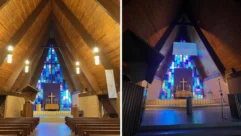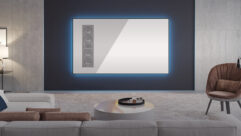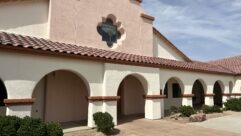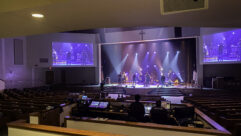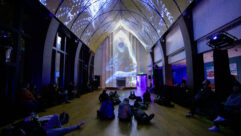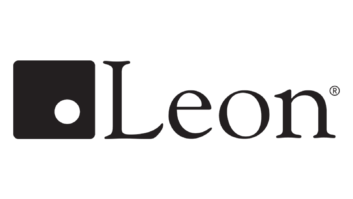SVC Podcast – Show Notes –
In this edition of the SVC Podcast, Contributing Editor Bennett Liles talks with Steve Diamond of Diamond Support Services about an installation at Calvary Lutheran Church in Grants Pass, Oregon consisting of two new Eiki EK-810U WUXGA 8,000 lumen large venue laser projectors—each outfitted with a long throw lens. Steve reveals how the church is striving to attract younger members into its congregation using more modern AV assets.
Links:
- Calvary Lutheran Church in Grants Pass, Oregon
- Diamond Support Services – Acoustics, Audio, Video & Lighting
- Eiki EK-810U large venue projector
- The ATEN 0404H 4×4 matrix switcher used to route signals to the projectors
Download Podcast Here:
https://s3.amazonaws.com/nb-svc/public/public/190-1_Diamond_Support_Svcs…
This is the SVC Podcast from Sound & Video Contractor Magazine with Steve Diamond of Diamond Support Services. Show notes and product links for this one other SVC podcasts are at svconline.com.
The Calvary Lutheran Church in Grants Pass, Oregon wanted to expand its congregation to include younger members and one way to do that was to install two large projection screens with hymn lyrics and other visual items. They called in Diamond Support Services for the installation and Steve Diamond is here to tell us how it all went. That’s coming up right now on the SVC Podcast.
Steve, thanks for joining us from Diamond Support Services in Junction City, Oregon. And we’re going to be talking about the Calvary Lutheran Church nearby in Grants Pass. They wanted to get more into big screen video. And that church has an older congregation?
They are an older congregation, there’s no question about it, but they are striving to draw younger families and youth into the church. And part of their reason for installing the video is to give them technology that younger families and youth are used to so that they can do more to draw them. And that’s what they’re trying to do. [Timestamp: 1:21]
And when those churches call Diamond Support Services, what are they looking for? What do you mainly do for them?
Our mission is to serve the body of Christ. I have been in the audio field since 1973, so I’ve got a few years under my belt. I had a company here in Oregon that did national and international work for many years and last fall I sold my percentage in the company. And the new company that purchased the company that we had had a different vision. They only wanted to serve mega churches and work with budgets that were fairly large. My heart has always been to serve the smaller and medium-sized churches and so we parted company the beginning of December of last year. And in January I started Diamond Support Services to continue to serve the smaller and mid-sized churches. We do large churches, too, don’t get me wrong. But my focus is definitely small and mid-sized because they tend to be the ones that really need some guidance and some help with honesty. And you have quite a few dealers out there who their main focus is sales, and my main focus is serving the church. So I tend to give them good deals, but more than that I give them solid advice and really take into account their budgets. I try not to exceed their budgets, but I am a realist with them. And I also tend to move them towards wise stewardship decisions where they’re spending the money once and spending it wisely. Not necessarily buying cheap. It may be expensive, but it’s something that will last them a decade or two. And I feel that is a much better value than selling them something they fight with and then five years later they replace it because they’re too tired of fighting with it. [Timestamp: 3:07]
And what was it that they wanted to accomplish by installing the new projection system? You mentioned the younger crowd. Were they just trying to blend the congregation better and get into a little more sophisticated video system?
They’re trying to blend the church better. They have a good contingent of seniors and they’re trying to draw in those families and the youth. They’re trying to get a little younger in their technology as a way of being attractive to the younger generations. Previously, they used a small projector that was just sitting on a cart and they would pull down a screen and put the words and sermon notes and that kind of thing on the screen, and the seniors couldn’t see it very well. The room has three glass walls. The rear wall and the two side walls are predominantly glass and there’s a tremendous amount of horizontal light that comes into the room through all that glass. So that was one of the challenges about getting them to a good solution where the seniors could read the words clearly and see clearly and the youth would come in and go, “Wow, they have cool video.” [Timestamp: 4:12]
Yeah, I can see why they why they would find that to be more engaging.
Yeah. So that’s kind of what we were up against. The video they had was terribly washed out and really did not function well. It was just kind of a stop gap measure on their part. I’ve been working with them for close to a year and a half to find a video solution that would work for them in that space. And one of the things when we started, it was like gee, this is expensive. Yes, you need a high-power projector to overcome some of this light, but you still have issues with all that horizontal light coming in. And we investigated motorized, drop-down shades that would cover some of the glass. We talked about curtains being pulled over the glass and all that kind of stuff. But most of the people in the church were very taken by the architectural aspects of the building and didn’t want to block out all the natural light that was coming into the room. So those solutions we kind of worked through and they weren’t 100 percent sold on it. We did mock-up of screens and showed them where the screens would hang, that kind of thing, but they weren’t really taken by the aesthetic at that point in time. [Timestamp: 5:20]
So you installed a couple of Eiki 810U projectors I think. What was the attraction of those particular ones?
Yes, we did put in Eiki 810U’s. The attraction was two-fold. First of all, it’s an 8,000-lumen projector and 8,000 lumens is pretty good power at a reasonable price as far as the ability to cut through the existing light and space. And the second aspect is that it was a dual laser, and that in itself has a couple of benefits. But the dual laser has a blue laser and a red laser, so color rendition is extremely true and extremely natural-looking. Plus it has an extremely high contrast ratio in those projectors. You’re looking at about 100,000 to 1 contrast ratio. And of course the contrast ratio means that the blacks are blacker and the whites are whiter. And when you look at a standard incandescent-style bulb projector you’re talking contrast ratio is typically in the 3,000 to 1, maybe 5,000 to 1 area as opposed to 100,000 to 1. So contrast was really important, especially for the seniors in that congregation to be able to see writing clearly. [Timestamp: 6:30]
I can see that with the ambient light level how the contrast ratio would be a very big factor. Now I know that you probably didn’t have to do the whole thing by yourself so who helped out on the installation?
I have a couple of guys that I work with regularly. One – my lead is Enoch Howell, who is a certified technology specialist, CTS-D. There’s only about 2,000 of them in the world and he’s one of them. So he’s a tremendous asset as far as our company being able to pull off this kind of thing. I did the design and the specification of the equipment. He did the installation, the tuning in and the actual hands-on work. I was there, mind you, working, but he did the bulk of directing that and he’s just absolutely terrific at it. [Timestamp: 7:20]
So you got together and put in these EK-810U projectors. I looked through the specs on these and there’s a liquid cooling feature for the optics. How does that work?
[Laughs] That’s a good question. I would think that is a closely-guarded secret. I don’t know the specific engineering regarding, but I will say this. The cooling aspect negates the need for filters in the projector. It is a sealed light unit. It has a 20,000 hour guarantee on it. It doesn’t require filters being changed or even being cleaned, so the maintenance is extremely low. And for an older congregation, having less maintenance is a big deal. [Timestamp: 8:00]
Yeah, I can imagine.
So just having it be less maintenance was big. A 20,000 hour guarantee is great, and you know, when we looked at the price of the projector everybody went, “Oh, that’s expensive.” Well, not really when you consider that if you want a really good picture you would have to replace the bulb every year or two and a good OEM bulb is $400.00-$500.00 a pop. And if you replace that, let’s say every two years instead of one, over the course of 10 years you’re doing several thousand dollars just in bulbs. So when you add that to the price of the reasonably high-power projector that gets you in that 8,000 lumen area the cost is not very much different to go with the laser. Better contrast ratio, better picture, truer colors. We had just stunning results when we put that in. [Timestamp: 8:49]
And from where do you control these projectors? What do you use, serial or LAN, how do you do that?
Everything is set in their little booth at the back corner of the room. Not my favorite place to put a booth, but that’s where it is. It is definitely a wired LAN. They use an iMac through an ATEN matrix and the wired LAN gives us a very good IP control and allows us to remote in, if necessary, to help them. That’s a big deal. [Timestamp: 9:18]
That would be a giant thing for them not to have to wait for you to get down there to the church to do something or check something that you could do remotely.
Right. When you say “get down there to the church,” it’s 200 miles away.
That’s a mighty long trek anyway.
Yeah. So getting down there is like gee, is there another way we can pull this off without me hopping in the car and driving?
At least you can look at some diagnostics and see if there’s something that’s about to go bad or not working right on those.
We also set it up that the projector would notify us if something goes wrong. So we know sometimes before they do if there’s a problem. We haven’t had any so far so everything is good, but that is something we definitely looked at in setting up the IP control. [Timestamp: 10:01]
And how do you get the video signal up to the projectors? Is it HDBaseT or how do you handle the video signal?
We are doing HDBaseT and we use an ATEN, four-in/four-out matrix so that they can hook up their computer and they can hook up a DVD player and whatever. And that gives us the ability to get the signal right up to the projectors. [Timestamp: 10:21]
Sounds like the easiest way to get all the sources up there and once you do, what’s the actual throw distance from the projectors to the screens?
There are two screens, two projectors. From each projector it’s a 57-foot throw to the screen. So long-throw lenses were specified along with the projectors. The projectors basically don’t come with a lens; you specify the lens. [Timestamp: 10:42]
Sounds like an installation that had a significant impact on the whole personality of the church and their congregation. Next week we’ll get more into how you did the church’s sound system. Thanks for getting with us on it, Steve. It’s Steve Diamond of Diamond Support Services in Junction City, Oregon and the Calvary Lutheran Church projection display upgrade. Thanks Steve, for getting with us.
Sure, and talk to you next week.
Nice to have you with us for the SVC Podcast with Steve Diamond. Show notes and product links for this one and others can always be found at svconline.com. Next week Steve will tell us about the Crystal Screens display surfaces installed for the Calvary Lutheran Church. That’s on the next SVC Podcast.


